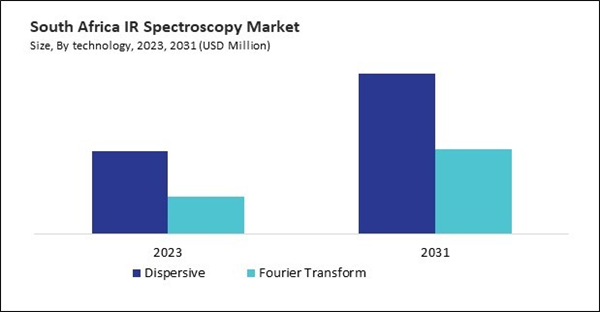The Brazil market dominated the LAMEA IR Spectroscopy Market by Country in 2023, and would continue to be a dominant market till 2031; thereby, achieving a market value of $41.5 million by 2031. The Argentina market is showcasing a CAGR of 9.2% during (2024 - 2031). Additionally, The UAE market would register a CAGR of 8.3% during (2024 - 2031).
The collaborations between academia, industry, and government agencies are fostering innovation and knowledge exchange, further fueling the adoption and utilization of IR spectroscopy in healthcare and clinical research settings. Also, the growing adoption of IR spectroscopy in healthcare institutions and clinical research centers is driven by factors such as technological advancements, expanding research capabilities, and the increasing recognition of the value of molecular spectroscopy techniques in biomedical research and clinical practice.
Environmental monitoring and analysis also drive demand for IR spectroscopy solutions, particularly in fields such as environmental science, agriculture, and pollution control. IR spectroscopy enables the detection and quantification of environmental pollutants, toxins, and contaminants in air, water, soil, and biological samples. It supports efforts to assess environmental risks, monitor ecosystem health, and develop sustainable solutions for environmental management and remediation.
The expanding demand for IR spectroscopy in the LAMEA region is driven by a combination of industrial growth, increasing environmental concerns, advancements in technology, and the expanding healthcare sector. The healthcare industry in Saudi Arabia is a significant contributor to the growth of the IR spectroscopy market. Hence, the regional market will grow rapidly throughout the forecast period.
Based on Technology, the market is segmented into Dispersive and Fourier Transform. Based on Type, the market is segmented into Near-infrared Spectroscopy, Mid-infrared Spectroscopy, and Far-infrared Spectroscopy. Based on Product Type, the market is segmented into Benchtop Spectroscopes, Micro Spectroscopes, Portable Spectroscopes, and Hyphenated Spectroscopes. Based on End-user, the market is segmented into Healthcare & Pharmaceuticals, Chemicals, Food & Beverages, Biological Research, Environmental, and Consumer Electronics. Based on countries, the market is segmented into Brazil, Argentina, UAE, Saudi Arabia, South Africa, Nigeria, and Rest of LAMEA.
List of Key Companies Profiled
- Shimadzu Corporation
- Carl Zeiss AG
- Revvit, Inc
- Agilent Technologies, Inc.
- Bruker Corporation
- ABB Group
- Thermo Fisher Scientific, Inc.
- Horiba Ltd.
- Sartorius AG
- Hitachi High-Tech Corporation (Hitachi, Ltd)
Market Report Segmentation
By Technology- Dispersive
- Fourier Transform
- Near-infrared Spectroscopy
- Mid-infrared Spectroscopy
- Far-infrared Spectroscopy
- Benchtop Spectroscopes
- Micro Spectroscopes
- Portable Spectroscopes
- Hyphenated Spectroscopes
- Healthcare & Pharmaceuticals
- Chemicals
- Food & Beverages
- Biological Research
- Environmental
- Consumer Electronics
- Brazil
- Argentina
- UAE
- Saudi Arabia
- South Africa
- Nigeria
- Rest of LAMEA
Table of Contents
Companies Mentioned
- Shimadzu Corporation
- Carl Zeiss AG
- Revvit, Inc
- Agilent Technologies, Inc.
- Bruker Corporation
- ABB Group
- Thermo Fisher Scientific, Inc.
- Horiba Ltd.
- Sartorius AG
- Hitachi High-Tech Corporation (Hitachi, Ltd)
Methodology

LOADING...









